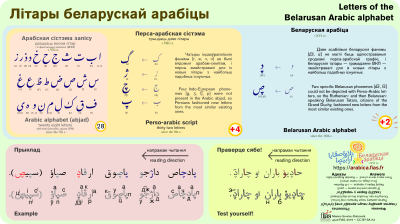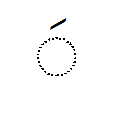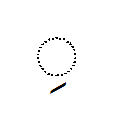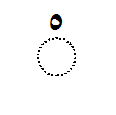Belarusian Arabic alphabet


The Belarusian Arabic alphabet (Belarusian: Беларускі арабскі алфавіт, romanized: Biełaruski arabski ałfavit) or Belarusian Arabitsa (بَلاروُسقایا ارابیࢯا, Беларуская Арабіца, Biełaruskaja Arabica)[1] was based on the Arabic script and was developed in the 16th century (possibly 15th). It consisted of twenty-eight graphemes, including several additions to represent Belarusian phonemes not found in the Arabic language.
The Belarusian Arabic alphabet was used by the Lipka Tatars, who had been invited to settle in Belarusian territory, at the time part of the Grand Duchy of Lithuania. During the 14th–16th centuries they gradually stopped using their own language and started using the Old Belarusian language rendered in the Belarusian Arabic alphabet. Books of that literary tradition are known in Belarusian as Kitab (Belarusian: "Кітаб"), which is Arabic for written material.

Some Polish texts were also written in the Arabic script in the 17th century or later.[2]
Additional graphemes
- For the sounds /ʒ/ (ж), /t͡ʃ/ (ч) and /p/ (п), which are absent from the Arabic language, the following Persian graphemes were used:
- For denoting the soft /d͡zʲ/ (дзь) and /t͡s/ (ц) sounds, the following newly constructed graphemes were used:
- These graphemes were used during the 16th–20th centuries to write Belarusian and Polish.[2]
- و
Equivalence chart
Vowels
-
Vowels A and E (initial اَ)
-
Vowels I and Y (initial اِ)
-
Vowels U and O (initial اُ)
-
No vowel
-
Consonant gemination
/a/ is consistently written long (that is, with a mater lectionis), while /e/ is consistently written short.
/o/ is most commonly written long.[3]
Consonants
Ligature
| Cyrillic | Latin | Arabic | |||
|---|---|---|---|---|---|
| Contextual forms | Isolated | ||||
| Final | Medial | Initial | |||
| Ла ла, Ля ля | Ła ła, La la | ـلا | لا | ||
Sample Text
Below is a sample text, Article 1 of the Universal Declaration of Human Rights.[4]
| English Translation | All human beings are born free and equal in dignity and rights. They are endowed with reason and conscience and should act towards one another in a spirit of brotherhood. |
|---|---|
| Belarusian Cyrillic Alphabet | Усе людзі нараджаюцца свабоднымі i роўнымі ў сваёй годнасці i правах. Яны надзелены розумам i сумленнем i павінны ставіцца адзін да аднаго ў духу брацтва. |
| Belarusian Latin Alphabet | Usie ludzi naradžajucca svabodnymi i roŭnymi ŭ svajoj hodnasci i pravach. Jany nadzieleny rozumam i sumlenniem i pavinny stavicca adzin da adnaho ŭ duchu bractva. |
| Belarusian Arabic Alphabet | اُسَ لُوࢮِ نٰارٰاجٰاژُوࢯّٰا صْوَبَودنِمِ اِ رَووْنِمِ اوُ صْوَيَويْ هَودنٰاصْࢯِ اِ پرٰاوٰاحْ. يٰانِ نٰاࢮَلَنِ رَوزُومٰامْ اِ صُومْلَنَّمْ اِ پٰاوِنِّ صْتٰاوِࢯّٰا آࢮِنْ دٰا آدْنٰاهَو اوُ دُوحُو بْرٰاࢯْتْوٰا. |
See also
- Belarusian Latin alphabet
- Arebica – modified Arabic script used for Serbo-Croatian
References
- ^ a b Maxime Seveleu-Dubrovnik, The Belarusian Arabic alphabet initiative at the FIAS. https://arabica.fias.fr/pages/origin-en(Archive)
- ^ a b Ilya Yevlampiev, Karl Pentzlin and Nurlan Joomagueldinov, N4072 Revised Proposal to encode Arabic characters used for Bashkir, Belarusian, Crimean Tatar, and Tatar languages, ISO/IEC JTC1/SC2/WG2, 20 May 2011. (Archive)
- ^ "Антон Антановіч. Беларускія тэксты, пісаныя арабскім пісьмом". knihi.com (in Belarusian). Retrieved 2022-05-27.
- ^ Omniglot, Zarmahttps://www.omniglot.com/writing/zarma.htm
Further reading
- Akiner, Shirin. Religious Language of a Belarusian Tatar Kitab: A Cultural Monument of Islam in Europe. Otto Harrassowitz, 2009.
- Д-р Я. Станкевіч. Беларускія мусульмане і беларуская літаратура арабскім пісьмом. [Адбітка з гадавіка Беларускага Навуковага Таварыства, кн. I.] – Вільня : Друкарня Я. Левіна, 1933 ; Менск : Беларускае коопэрацыйна-выдавецкае таварыства ″Адраджэньне″, 1991 [факсімільн.]. – 3-е выд.
- Антон Антановіч, "Беларускія тэксты, пісаныя арабскім пісьмом"




